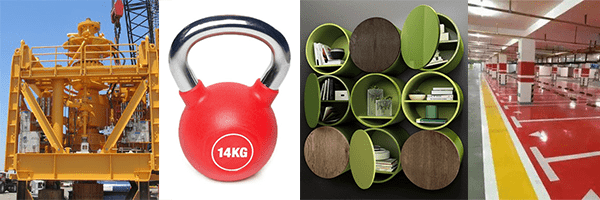Epoxy and urethane refer to the types of resins.
Epoxy paint and
urethane paint are typically 2-part coating products that are often used in industrial environments or for Original Equipment Manufacturer (“OEM”) applications where durability and chemical resistance is required. Urethane coatings and epoxy coatings share many similarities but also some differences. Often they will be used in conjunction as part of an overall system depending on what needs to be painted.
Epoxy paint and urethane paint are typically 2-part systems involving a Part A (resin) and Part B (catalyst or hardener). The correct ratio of Part A and Part B depends on the particular product and is often sold as premeasured kits. The most common ratios are 4:1 or 1:1, but it varies. The A and B parts are mixed before use. Once mixed, the paint will start to dry and you will have a limited amount of time to paint (this is often called “pot life”).
Both epoxy paint and urethane paint typically will dry very hard and offer a high degree of water, chemical, abrasion and impact resistance.
Epoxy paint tends to be thicker (higher build) and do a better job of filling cracks and surface imperfections. Epoxy resins also offer excellent adhesion to most surfaces and tend to be more forgiving over less-than-ideal prepared substrates. For this reason, epoxy coatings are preferred for use as primers over ferrous and non-ferrous metals, concrete, and masonry surfaces.
Epoxy primer also tends to form a very rust-inhibitive base. Epoxy coatings can also be used in immersion applications. However, Epoxy paints are sensitive to UV light and cannot be used for exterior topcoat applications. The epoxy coating will chalk and fade when exposed to UV light.
Urethane paints are thinner than epoxy paints, but are generally more resistant to chemicals, abrasion and impact and perform as a more durable coating. Urethane paint is also UV resistant and can be used as an exterior topcoat. Urethane paint cannot be used for immersion service.
Oftentimes, an epoxy primer is used underneath a urethane paint topcoat. The urethane topcoat protects the epoxy from UV light, while the epoxy primer provides a very strong and forgiving base coat that adheres well to the underlying substrate. This epoxy/urethane system leverages the strengths of each paint type.
Both epoxy paint, epoxy primer, and urethane paint are fairly technical coatings. Care must be used in the application as well as determining the proper preparation and products to use based on the substrates and application requirements. There are many different types of epoxy and urethane coatings.
Contact MyPerfectColor support for help in determining the best products to use for your application.
With more than 250,000 colors, MyPerfectColor offers the largest selection of colors anywhere including difficult to match industry standard colors such as
Pantone,
RAL,
Federal Standard and
Munsell, matches of many powder coats including
Tiger Drylac and IFS Coatings as well as matches of any major paint brands including Sherwin Williams, Benjamin Moore, Behr and much more. MyPerfectColor will also precisely match the color and sheen of specific parts, samples or production standards if you need
touch up paint.
| | |
| TEST DATA | Aliphatic Acrylic Urethane | Polyamide Epoxy |
| Flexibility (ASTM D1737) | Pass 1/4” Mandrel | Pass 3/16” Mandrel |
| Sag Resistance (w/-90B) | | Passes 8+ mils |
| Sag Resistance (w/-91B) | | Passes 8+ mils |
| Sag Resistance (w/92B) | | Passes 16+ mils |
| Dry Heat Resistance | 300 °F | 300 °F |
| Wet Heat Resistance | 125 °F | 150 °F |
| Adhesion (ASTM D3359) | Pass 5B | Pass 5B |
| Accelerated Weathering (ASTM G53) | 1000 Hours 1 coat V150 Primer, 2 coats V500
95% Gloss Retention
< 1.5 DE Color Change (CMC) | |
| | |
| Steam Resistance | | Yes |
| Humidity (ASTM D4585) | | (2 coats over V150 – 1000 Hours)
Face Corrosion: None
Face Blistering: None
Rating: 10, Rust: 0.00% |
| Salt Spray (ASTM B117) | 400 Hours (1 coat V150 Primer, 2 coats V500)
Rust Breakthrough: 10 Rating
Rust Area: 0.01% | (2 Coats
over V150 (1000 Hours)
Face Corrosion: None
Face Blistering: None
Rating: 10, Rust: 0.00% |
| Abrasion Resistance (ASTM D4060) Taber (CS-17 Wheel, 1000g load, 1000 cycles) | 44 mg. loss | |
| | |
| CHEMICAL RESISTANCE GUIDE (NON-IMMERSION) | Aliphatic Acrylic Urethane | Polyamide Epoxy |
| Fresh Water | Excellent | Excellent |
| Salt Water | Excellent | Excellent |
| Acids | Excellent | Good |
| Alkalis | Excellent | Good |
| Solvents | Excellent | Excellent |
| Fuel | Excellent | Good |
| Acidic Salt Solutions | Excellent | Excellent |
| Alkaline Salt Solutions | Excellent | Excellent |
| Neutral Salt Solutions | Excellent | Excellent |

